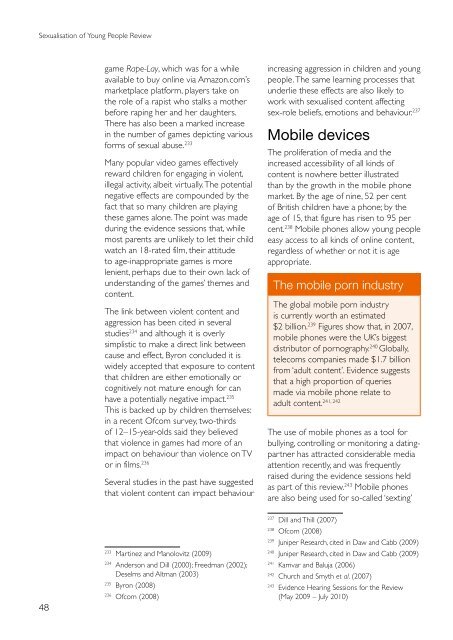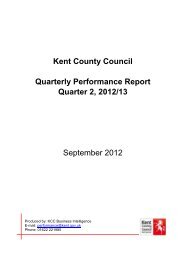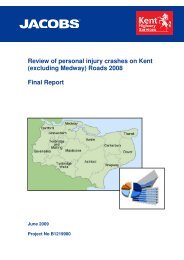Sexualisation of Young People Review
Sexualisation of Young People Review
Sexualisation of Young People Review
Create successful ePaper yourself
Turn your PDF publications into a flip-book with our unique Google optimized e-Paper software.
<strong>Sexualisation</strong> <strong>of</strong> <strong>Young</strong> <strong>People</strong> <strong>Review</strong><br />
game Rape-Lay, which was for a while<br />
available to buy online via Amazon.com’s<br />
marketplace platform, players take on<br />
the role <strong>of</strong> a rapist who stalks a mother<br />
before raping her and her daughters.<br />
There has also been a marked increase<br />
in the number <strong>of</strong> games depicting various<br />
forms <strong>of</strong> sexual abuse. 233<br />
Many popular video games effectively<br />
reward children for engaging in violent,<br />
illegal activity, albeit virtually. The potential<br />
negative effects are compounded by the<br />
fact that so many children are playing<br />
these games alone. The point was made<br />
during the evidence sessions that, while<br />
most parents are unlikely to let their child<br />
watch an 18-rated film, their attitude<br />
to age-inappropriate games is more<br />
lenient, perhaps due to their own lack <strong>of</strong><br />
understanding <strong>of</strong> the games’ themes and<br />
content.<br />
The link between violent content and<br />
aggression has been cited in several<br />
studies 234 and although it is overly<br />
simplistic to make a direct link between<br />
cause and effect, Byron concluded it is<br />
widely accepted that exposure to content<br />
that children are either emotionally or<br />
cognitively not mature enough for can<br />
have a potentially negative impact. 235<br />
This is backed up by children themselves:<br />
in a recent Ofcom survey, two-thirds<br />
<strong>of</strong> 12–15-year-olds said they believed<br />
that violence in games had more <strong>of</strong> an<br />
impact on behaviour than violence on TV<br />
or in films. 236<br />
Several studies in the past have suggested<br />
that violent content can impact behaviour<br />
increasing aggression in children and young<br />
people. The same learning processes that<br />
underlie these effects are also likely to<br />
work with sexualised content affecting<br />
sex-role beliefs, emotions and behaviour. 237<br />
Mobile devices<br />
The proliferation <strong>of</strong> media and the<br />
increased accessibility <strong>of</strong> all kinds <strong>of</strong><br />
content is nowhere better illustrated<br />
than by the growth in the mobile phone<br />
market. By the age <strong>of</strong> nine, 52 per cent<br />
<strong>of</strong> British children have a phone; by the<br />
age <strong>of</strong> 15, that figure has risen to 95 per<br />
cent. 238 Mobile phones allow young people<br />
easy access to all kinds <strong>of</strong> online content,<br />
regardless <strong>of</strong> whether or not it is age<br />
appropriate.<br />
The mobile porn industry<br />
The global mobile porn industry<br />
is currently worth an estimated<br />
$2 billion. 239 Figures show that, in 2007,<br />
mobile phones were the UK’s biggest<br />
distributor <strong>of</strong> pornography. 240 Globally,<br />
telecoms companies made $1.7 billion<br />
from ‘adult content’. Evidence suggests<br />
that a high proportion <strong>of</strong> queries<br />
made via mobile phone relate to<br />
241, 242<br />
adult content.<br />
239240241242<br />
The use <strong>of</strong> mobile phones as a tool for<br />
bullying, controlling or monitoring a datingpartner<br />
has attracted considerable media<br />
attention recently, and was frequently<br />
raised during the evidence sessions held<br />
as part <strong>of</strong> this review. 243 Mobile phones<br />
are also being used for so-called ‘sexting’<br />
48<br />
233<br />
Martinez and Manolovitz (2009)<br />
234<br />
Anderson and Dill (2000); Freedman (2002);<br />
Deselms and Altman (2003)<br />
235<br />
Byron (2008)<br />
236<br />
Ofcom (2008)<br />
237<br />
Dill and Thill (2007)<br />
238<br />
Ofcom (2008)<br />
239<br />
Juniper Research, cited in Daw and Cabb (2009)<br />
240<br />
Juniper Research, cited in Daw and Cabb (2009)<br />
241<br />
Kamvar and Baluja (2006)<br />
242<br />
Church and Smyth et al. (2007)<br />
243<br />
Evidence Hearing Sessions for the <strong>Review</strong><br />
(May 2009 – July 2010)

















